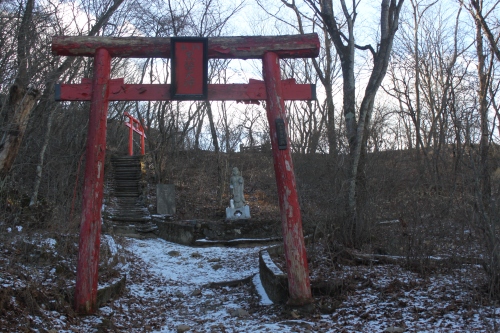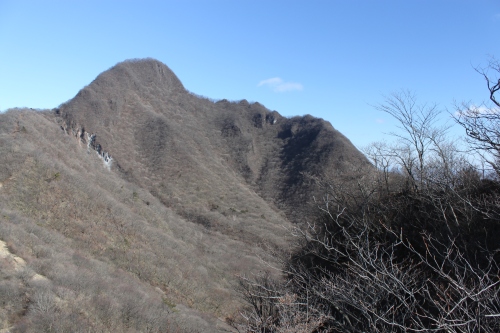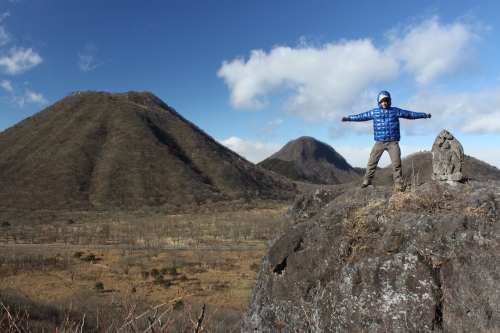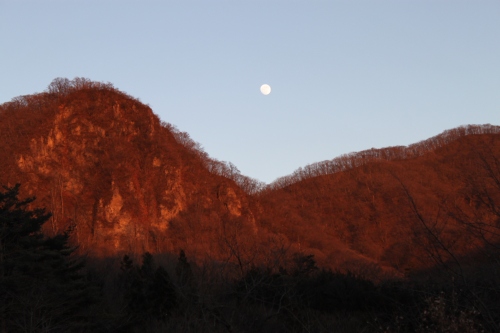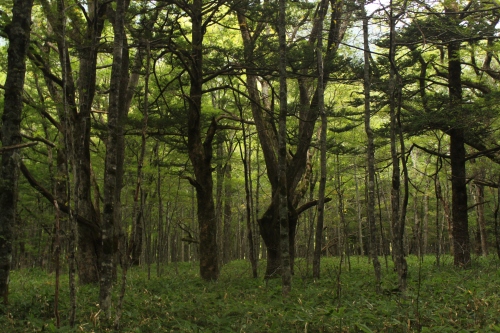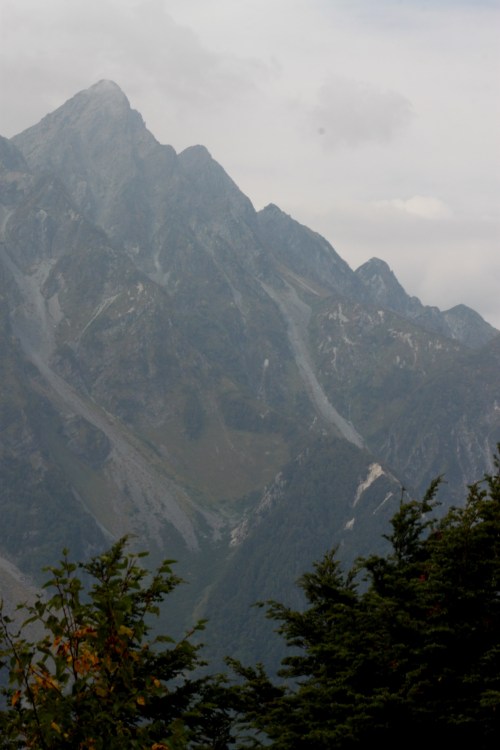I spent the majority of my first trip up Mt. Sanjo in the middle of a massive world of cloud, so when presented with a fair weather opportunity to get revenge on the peak, I took Paul up on his generous offer to carry both the tent and cooking gear. We boarded an early morning Kintetsu train to Shimoichi-guchi before boarding that familiar bus to Dorogawa hot spring. It had been nearly a decade since I had been in the Omine mountains, and the memory of the trail had started to fade. For one, I didn’t remember walking so long on the paved road out of town just to reach the trailhead. After stopping to fill up on water at the gorogoro water source, we arrived at the cemetery marking the path entrance, sometime in the early afternoon under a crystal blue sky and a light, chilling breeze.

The sign forbidding women to enter the ‘holly’ mountain still stood, though a bit more weatherbeaten than before. The first part of the trail tramps through a forest laden with planted cedar and cypress before skirting the edge of the valley towards the untouched deciduous heights of the main ridge line. We passed through a deserted tea house built directly over the trail that likely serves refreshments to the hoards of pilgrims that make their way to Sanjo every year, but then again I wouldn’t know. My first time here was also out of season, with everything boarded up for the winter. In fact, the entire mountain lay deserted in the early November haze.

Paul and I marched on, reaching the junction of the main ridge sometime around 3pm or so. A giant statue of Bishamon, the guardian of these lands, met us and looked ready to interrogate about our unsolicited visit. The trail to the left pointed us in the direction of Yoshino, two dozen kilometers away. To our right, we could stay on this ridge all the way to Hongu shrine if we felt so inclined, nearly 100km in the other direction. We turned right and soon reached another boarded up tea house, the walls of which were adorned with hundreds of business cards fastened by pilgrims and other visitors. Not to pass up an opportunity for free advertising, I made some space on the wall for one of my own.
The trail rose through an area of boulders on our right, which led to an outcropping with the blue kanji letters 西の覗 carved intricately into one of the boulders. During the summer, buddhist monks will hang you over the edge of the cliffs by your feet while testing your devotion to Buddhist teachings, but only during the months that the temple is actually in operation. In the late afternoon light we stared straight down into the valley awestruck by the beauty encapsulating the sacred peak.

We pushed on, reaching the deserted temple complex just as the evening clouds invaded the peak. Our views towards Nara were obstructed by the damp mist, so we retreated further south along the ridge, to a small wooded campsite marked on the map as the only place to stay in the off season. Arriving shortly before dusk, we contemplated setting up the tent before opting for the comfort of the small shack that served as an emergency hut. The hut which sleeps 4 comfortably, was occupied by Fukayama-san, a late-20s, male Japanese hiker out on his own. He had also finished climbing the Hyakumeizan, and we immediately hit it off. He was on assignment to gather data for his amazing blog of panoramic mountain photos. Back on Tanzawa a few years back, I had met the acquaintance of a man named Satoshi who also took advantage of the digital technology to produce panoramic photos. How many more of these talented bloggers would I cross paths with?

Paul and I cooked dinner in the fading light and tried unsuccessfully to keep a fire going in the dampness of the evening fog. We gave up, retreating to the comfort of the hut, which sheltered us from the approaching winter winds. The next morning, Fukayama headed out in front of us, wanting to get photos of Mt. Inamura on an adjacent ridge, while Paul and I leisurely downed our breakfast of muesli and coffee. We hit the trail shortly before nine in the morning, retracing our footprints back to Sanjo before turning north to follow in Fukuyama’s shadow. Along the way, we passed by a group of 5 hikers, including two females who brazenly ignored the antiquated men-only rule.

The route from Senjo took a nosedive, dropping off the side of a cliff before skirting around some multi-story rock formations. Ladders and metal platforms demanded our mental skills and energy, zapping excess reserves from our wary bones. By the time we bottomed out at the pass, I plopped down on the foundation of a wooden shrine gate marking the edge of the gender zone. Someone had scratched out the “No” on the No Women Allowed sign. Perhaps it was the same hiking party we’d met a few minutes earlier. As if driven by an internal magnetic force, I sat crashed out, refusing to budge. “Paul, I think I’m done,” I sheepishly confessed. Perhaps it was the lack of sleep or a mineral imbalance, but the thought of heading another hour along the ridge to Inamura was inconceivable. Just as we were deciding how to proceed, a few sprinkles fell from the sky. The clouds were closing in and the forecast wasn’t looking good. On our maps, a dotted trail led from our current position back to Dorogawa, as we made the conservative decision to seek shelter further below. Inamura would have to wait.

Dropping down into a forest ablaze with color wasn’t such a bad thing. My spirits perked up and I felt a lot more alive with energy once the pressure building up in my ears was released. Paul led the way through a spectacular collage of orange oaks and yellow maples, while we followed the watershed down to civilization. The rain held off for the time being, and by the time we reached a forest road several hours later both of us were screaming for nutrients. At the edge of a retaining wall we dangled our feet. Paul boiled water while I prepared the tuna salad sandwiches. The coffee flowing through our veins took our minds off the aching muscles and we sat back for a moment, reflecting on our progress. Sure we didn’t make our second target peak, but at least we had found one of the better gorges in the area. On the walk back into town the skies opened up and both of us praised our fortunate decision. After a quick bath at the hot spring, we headed back to Osaka with fresh thoughts of Inamura’s untapped crags.

